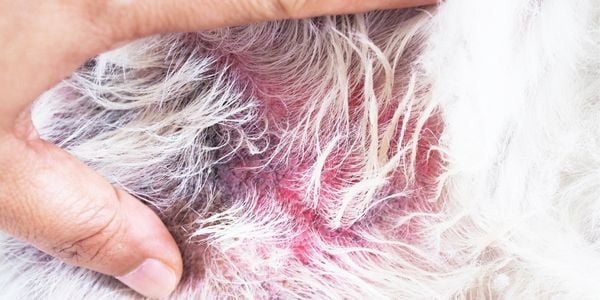
Depending on who you are and what you're doing, the slang term ‘hot spot’ has a very different meaning.
When it comes to dogs, it doesn't refer to wireless technology or a trendy nightclub. But it does mean there is increased activity or attention.
If you notice that your beloved canine companion is giving increased attention to a particular spot on their body, they may have their own ‘hot spot’!
Hot spots are no fun, but they may be treatable at home. I'll explain why they happen, how to treat them, and when you should seek veterinary help.
What Are Dog Hot Spots?
The term ‘hot spot’ comes from the fact that the skin feels warm due to the presence of inflammation. Other names for dog hot spots include pyotraumatic dermatitis or acute moist dermatitis.
Hot spots on dogs are typically red, inflamed, and oozy skin lesions that are painful, itchy, and pretty smelly. They can very quickly increase in size. They are usually the result of self-trauma (hence the name pyotraumatic). Dogs will scratch, bite, or lick an area so aggressively that it causes a wound.
See the list of reasons your dog may be suffering from hot spots.
Where Are Hot Spots Found On Dogs?
Hot spots can be found anywhere on your dog’s body, but they are generally on the head, neck, hips, and legs. While some may be obvious due to noticeable fur loss, some can be hidden below matted fur, long floppy ears, or under collars.
Treatment for Hot Spots at Home
If you catch it early, you can save your dog a lot of discomfort and yourself a lot of trouble.
When you catch your dog itching, check their skin. If the area is small, one to two spots, and it's not too red and crusty, oftentimes, you can manage it at home.
Always use caution when treating hot spots at home. Your dog may not seem painful, but they are and may bite when you attempt to clip or clean the site.
Here are some steps to take care of your dog's hot spots at home:
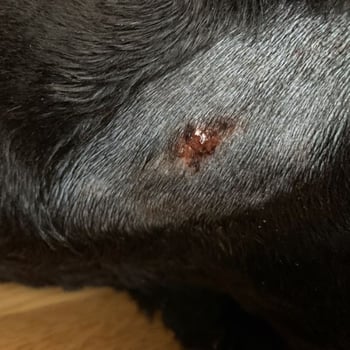 Clip away the fur
Clip away the fur
Use an electric beard trimmer (a useful tool for all dog owners to have!) to gently clip away the fur on top of the area. Clip liberally so as to allow good air contact and circulation of the hot spot.
I generally recommend trimming an area about ½ to 1 inch from the edges of the hot spot, so you see ‘normal’ skin (similar to the photo example). This allows you to determine if the area is spreading or worsening. Additionally, if your dog has longer fur, it won’t become matted or tangled.
Clean the area
Gently clean the area with pet-safe antibacterial wipes/pads, a mild soap (Cetaphil or Castile), or antibacterial cleaners (i.e., chlorhexidine) once to twice daily.
Some wipes/pads you can try include:
NOTE: If your dog is sensitive to you touching the hot spot, you can rinse the area with saline and then spray with a pet-safe antibacterial spray (Douxo or Vetericyn).
NOTE: Avoid using astringents, such as rubbing alcohol or witch hazel, as they'll dry your dog's skin and cause them pain. Also, avoid treating dog hot spots with hydrogen peroxide, as it can hinder the healing process.
Keep the area moist
To help keep the area moist and protected after cleaning (be sure the spot is dried first), apply triple antibiotic ointment, HoneyCure, or ZYMOX.
Prevent licking, chewing, and scratching
Keep your dog from licking, biting, chewing, or scratching at the area. In some cases, once you start treating it, they may leave it alone. BUT in most cases, we aren’t that lucky. You can try an Elizabethan collar (cone), covering the area with a bandage/wrap, or keep them distracted with a lick mat.
NOTE: In some cases, Benadryl (diphendydramine) can help relieve some of the itch. Use our handy calculator to determine your dog’s dose.
If the area does not start to improve within a couple of days or worsens, seek veterinary care.
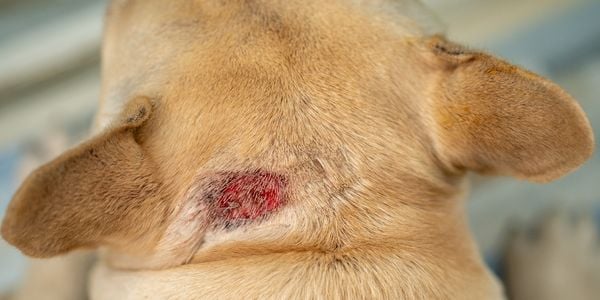
Time for a Veterinary Visit!
Sometimes you don’t catch the hot spot early as it is developing. If you answer yes to any of these questions about your dog’s hot spot, it is time for a visit to your veterinarian:
- It isn’t improving with treatment at home?
- Is a large area affected?
- Are there multiple locations?
- Is your dog's skin very reddened and inflamed?
- Is the skin broken?
- Is the area covered in crusty scabs?
- Is your dog severely itchy?
- Is your dog painful?
- Is the hot spot near your dog’s ear, and does the ear canal look red, inflamed, or have an odor?
Don’t hesitate to go to your veterinarian. They can help you and your dog clear up the problem more quickly.
Hot spots that get to the broken skin and really inflamed stage are also more painful (don't use human pain relief) — meaning not only that your dog might require veterinary-prescribed pain medication but also that your dog might be more likely to bite you or suffer in silence from pain if you try to deal with their hot spot at home.
Some dogs need to be sedated to have their hot spots safely, comfortably, and most effectively treated. That's how painful these relatively "innocent-sounding" things can be!
While you’re at your vet’s office, let them help you figure out why your dog is so itchy. There are lots of possible reasons, as listed below. The sooner you and your vet can get to the bottom of any underlying cause, the better it will be for your dog (and your bank account).
Treatments Your Veterinarian May Recommend for Your Dog's Hot Spots
The treatments your veterinarian will recommend will be based on the severity of your dog’s condition. But they will likely include one or more of the following:
Antibiotic
Be sure to give the medications as directed, and DO NOT stop them even if the hot spot looks fine before you finish them.
- PRO TIP: Read this article on pill wrapping to make medicating easier on you and pilling more fun for your dog.
- PRO TIP: Consider starting your dog on a probiotic if you have to give your dog antibiotics. Antibiotics kill both good and bad bacteria. Probiotics can help keep your dog’s gut microbiome in balance as well as help the skin microbiome. Additionally, they have been found to enhance the immune system, which is always beneficial, especially when your dog is dealing with skin issues. Be sure to give the antibiotics about 2 hours PRIOR to the probiotic. Check out our list of probiotics to consider for your dog.
Topical antibacterial wipes or sprays
These work great as a daily treatment of localized areas, especially in between baths. Use as directed by your veterinarian for best results. Be sure that your dog DOESN'T lick off the treatment following the application.
- PRO TIP: If using wipes, gently dab the area instead of rubbing it.
Pain medication
Hot spots, especially if they are severe or accompany other issues like ear infections, are painful even if your dog doesn’t show it. Be sure to give all meds as directed.
- PRO TIP: Be sure to give pain meds with food since they can sometimes cause stomach upset.
Medicated shampoo
There are instances where there is more than one hot spot, or it is accompanied by a skin infection. In these cases, your veterinarian may recommend a medicated shampoo to make overall treatment easier.
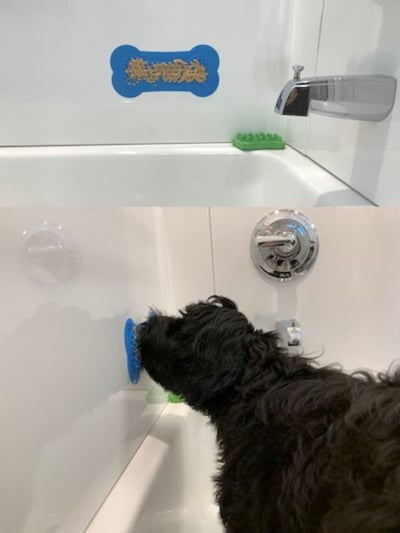 PRO TIP: For dogs that are not fans of baths, consider plugging an Adaptil diffuser in the room about 30 minutes before bath time and give them a calming treat such as VetriScience Composure treats. Read our article for more tips on how to help your dog feel comfortable in the bath.
PRO TIP: For dogs that are not fans of baths, consider plugging an Adaptil diffuser in the room about 30 minutes before bath time and give them a calming treat such as VetriScience Composure treats. Read our article for more tips on how to help your dog feel comfortable in the bath.- PRO TIP: To keep your dog occupied while the lather is sitting, you can distract them with a lick mat that sticks to tile, glass, or ceramic. Preventive Vet dog, Finnegan, enjoys his baths while licking pet-safe peanut butter off the lick mat.
- PRO TIP: Be sure to leave the lather on your dog’s skin for 10 to 15 minutes before rinsing with lukewarm water. For it to work, it needs contact time.
- PRO TIP: When bathing the sensitive skin of a mild hot spot, you can improve shampoo lathering and penetration, and possibly stimulate better blood flow (healing) to the area by using a soft silicone brush while lathering.
The FurBliss brush featured in the photo on the side of the tub, is medical-grade silicone, so it's durable yet soft and flexible enough to be used even on mildly inflamed skin. And it's dishwasher safe and doubles as a great fur remover from furniture! Gently brushing the skin can help increase blood and lymphatic flow, which promotes healing. Do not use on skin that is moderately to severely inflamed. Monitor your dog for any signs of discomfort or pain while brushing. If noted, stop immediately.
How Long Do Hot Spots Take to Heal?
If you notice that the hot spot is not improving within a week of starting treatment or you notice other areas are becoming affected, contact your veterinarian for a follow-up visit. Your dog may be suffering from other underlying medical issues and may require further diagnostic tests.
Pro Tip: Taking pictures of the area prior to treatment and during helps you and your veterinarian better evaluate the healing process. The photo below is a severe case near the tail. The black areas are dried, crusted blood that has scabbed over the area.
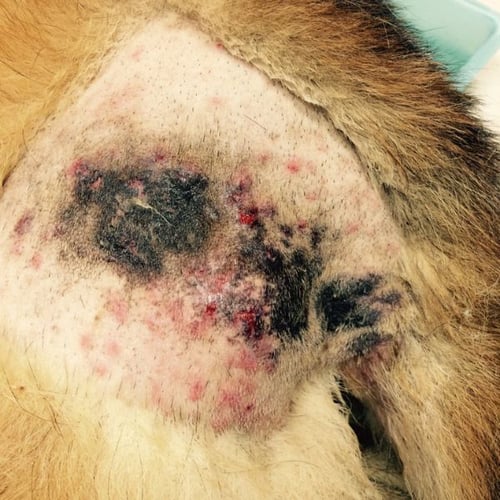
What Is Causing the Hot Spots?
There is a long list of reasons your dog may be itchy.
Some common causes of the itch, that could result in a hot spot:
Ear infections: The ear canal becomes irritated and itchy from bacteria and/or yeast being present. This causes your dog to scratch the area creating trauma to the neck, face, behind the ear, and the ear flap.
- NOTE: When dogs shake their head and scratch at their ear flap due to an ear infection, they can cause an aural hematoma. This makes the ear flap look like a ‘balloon.’
Ectoparasites: Bites from fleas, mites (Sarcoptes, Cheyletiella), or any other insect (i.e., mosquitoes, bees, gnats) can cause a reaction and itching.
Pyoderma: Dogs can develop skin infections caused by yeast and/or bacteria. The pruritus (itchiness) caused by these primary infections can cause your dog to develop a secondary hot spot.
- NOTE: Dogs with excess folds around their neck tend to develop pyodermas, especially under their collars. Be sure to keep the area clean and dry and routinely check the skin under the collar. This is especially important if the collar gets wet. When it's safe and possible, leave the collar off to allow the skin to breathe.
Collar issues: Be sure to remove your dog’s collar and dry it completely if they like to swim a lot, especially for dogs with excessive neck folds or long fur.
Routinely check your dog’s neck if they continuously wear a collar for an underground or electric fence. The prongs can cause irritation that can result in a pyoderma and itching. Your dog will then scratch or rub their neck region, causing pyotraumatic dermatitis (aka hot spot!).
Joint issues: When dogs have arthritis, they will lick or chew at the joint to soothe their discomfort or pain. Unfortunately, this can result in a hot spot.
Another way hot spots are created by arthritis is that the discomfort often causes them to lie around more or even become immobile. When this occurs, they can develop pressure sores or abrasions on the areas (hips or hocks) they are lying on.
Additionally, many of these dogs have decreased muscle mass due to the lack of use. The lack of muscle mass can be worse for elderly dogs. Without their muscular padding over bony protrusions, sores can occur. The sores or abrasions are licked, and a hot spot forms.
Anal gland issues: As if anal glands were not a pain in the butt on their own. When they become infected or impacted, they are painful. Additionally, if some of the ‘juice’ leaks out, it makes your dog’s rump itchy. In an attempt to express themselves as well as soothe the itch, dogs will drag their rumps on the ground, and lick or chew at their hind end. Hot spots can develop anywhere from the point of the hip to the base of the tail or around the anus.
Grooming problems: When a dog’s fur becomes matted or tangled, it can cause a wound on its own because air cannot reach the skin, and moisture builds up. This can then develop into a hot spot. Hot spots can also occur when dogs get ‘clipper burn’ when they are groomed. They will lick, chew, and bite at the irritated area and can create a hot spot.
Additionally, dogs will often bite or chew on matted fur or tangles to relieve the discomfort from it pulling at their skin. The end result is, you guessed it, a hot spot. Learn how to deal with mats in your dog's fur.
Trauma: Mild irritations or abrasions created in the skin, regardless of the cause, can develop into hot spots when dogs start rubbing, licking, chewing, or biting at them.
Boredom or Anxiety: Bored or anxious dogs may lick or chew on areas they can easily reach – similar to people biting their nails or twirling their hair. Typically, the areas that develop hot spots due to boredom or anxiety are their paws and front legs since they are often lying down when they engage in this activity. If you believe your dog is licking because they are anxious, it's crucial to address the underlying anxiety to prevent continual self-licking. Learn how to address dog anxiety.
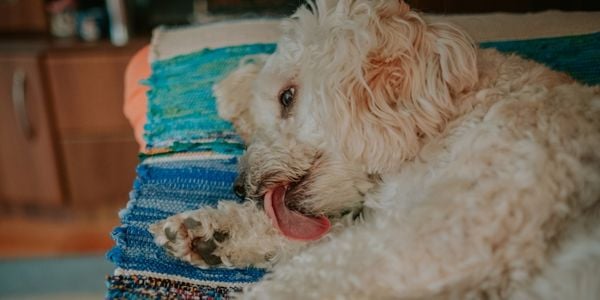
Prevention of Hot Spots
There are several things you can do in an effort to prevent hot spots:
Parasiticides: Keep your dog on flea/tick prevention year-round. Additionally, check them over regularly for signs of ectoparasites (i.e., fleas, flea dirt, redness)
Clean Ears: Evaluate your dog's ears weekly for any signs of infection (redness, odor, discharge). To help prevent infections, always clean your dog’s ears after a bath or swimming with a canine ear cleaner that is both cleansing and drying. If your dog has a predisposition to ear infections, clean their ears weekly regardless of whether they had a bath.
Rump Check: Inspect your dog's rump at least weekly, especially under the tail for any signs of irritation, discoloration, or bare areas.
- NOTE: For dogs with a history of anal gland issues, have their glands checked routinely by your veterinarian. Additionally, giving your dog extra fiber, such as green beans with no added salt or sugar – they can help bulk the stool up, which helps express the glands. There are also supplements, such as Glandex, that you can use to help prevent anal gland issues.
Check Groomed Dogs: For dogs that are groomed, whether at a groomer or at home, be sure to evaluate the skin for any irritations for a few days following the groom. Hot spots can occur when dogs get ‘clipper burn’ when they are groomed. They will lick, chew, and bite at the irritated area and can create a hot spot.
Check Dogs Who Are Arthritic: For dogs with mobility problems, check them daily for ‘bed sores’ or other abrasions. The sooner you address them, the less likely they are to develop into a problem. You'll want to provide your dog with a well-padded bed, and sometimes provide assistance getting up and laying down. Plus you need to move your several times per day – kinda like a hospitalized person. You can also place extra padding on the location using a bandage or wrap.
NOTE: If you suspect your dog is having mobility issues due to arthritis, consult with your veterinarian. There are pain medications and supplements they can recommend.
Help Dogs Who Suffer From Anxiety: For dogs with anxiety issues, especially if moderate to severe, consult with your veterinarian, a veterinary behaviorist, or a certified canine behavior consultant. For mild cases, increase activity, provide enrichment, use calming pheromones (i.e., Adaptil), calming treats (VetriScience Composure or Composure Pro treats), and/or calming music.
Reduce Humidity: Hot weather, especially humidity, can cause or complicate hot spots. Be sure to keep your dog cool as possible during those times of the year. You may want to consider using a dehumidifier. A reduction in the humidity will make the room more comfortable as well as make it feel cooler.
Prevention isn't always possible, but working toward it, and catching hot spots early helps you keep your dog happy so you have time to visit the ‘hot spots’ around town!




